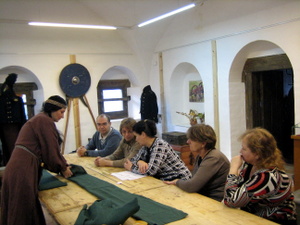 The educational seminar of history and social sciences teachers of the Kirillov district took place in the Kirillo-Belozersky museum-reserve on November 5. Its program was full of events. For example, during the tour “Monasteries of the Belozersk Region” in the Refectory, the teachers were told about history and culture of the Kirillo-Belozersky, the Ferapontov, the Nilo-Sorsky Monasteries and the Goritsy Convent, visited the Bell-tower and saw the exhibition “World of Bells”.
The educational seminar of history and social sciences teachers of the Kirillov district took place in the Kirillo-Belozersky museum-reserve on November 5. Its program was full of events. For example, during the tour “Monasteries of the Belozersk Region” in the Refectory, the teachers were told about history and culture of the Kirillo-Belozersky, the Ferapontov, the Nilo-Sorsky Monasteries and the Goritsy Convent, visited the Bell-tower and saw the exhibition “World of Bells”.
The year 2014 will mark the centenary of the beginning of the First World War. The lecture “Kirillov district during the First World War” was given in view of this important event in the history of the Russian state. The teachers also took part in the master-class “Slavonic Female Costume. History. Cut” that was delivered in the Guard-rooms.
During the seminar, they discussed certification issues and some aspects of teaching history in connection with the supposed new interpretation of historical events of Russia.
Museum employees also participated in the seminar: Ilya Smirnov, deputy director of the Kirillo-Belozersky museum-reserve; L.V. Terebova, head of the Scientific Department; I.A. Gostinshchikova, research officer of the Exposition and Exhibition Department; N.I. Khrulyova, head of the sector “Museum Children’s Centre”. The group of teachers was led by I.V. Romanova (the secondary school of Nikolsky Torzhok), head of the district association of history and social sciences teachers.







